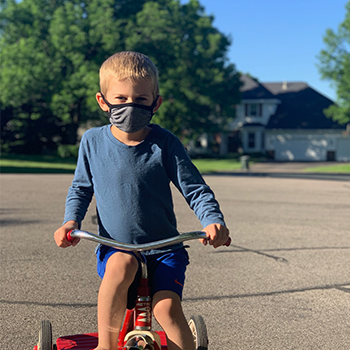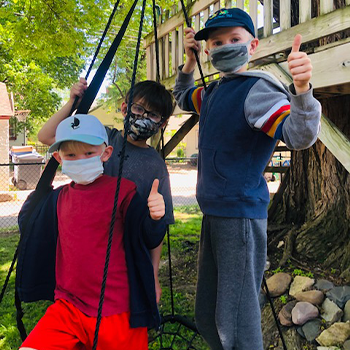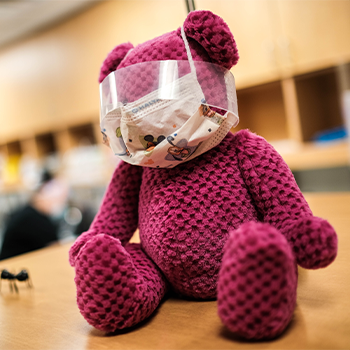As the state of Minnesota continues to move toward re-opening after the COVID-19 stay-at-home order, many public spaces ask or require everyone to wear cloth face masks. Laura Sufka, child life specialist at Children’s Minnesota, shares how you can talk to your children about wearing face masks, and gives tips to help make masks more comfortable.
How can I talk to my kids about wearing face masks?

Wearing a face mask is a new concept for many kids, so it’s important to help them understand why we wear masks when we are not sick. Although it’s important for kids to understand why face masks are so important, parents and caregivers should also validate their children’s concerns or fears about wearing a mask. This allows kids to process their feelings and feel more in control of the situation.
First, explain to kids that doctors and nurses recommend that we all wear masks so we can protect ourselves and others. Masks protect our own noses and mouths from germs, but wearing a mask can also protect others because it keeps our germs closer to our bodies.
Giving your child an age-appropriate explanation of what COVID-19 is can help them understand why face masks are important. Some tips from our child life team can be found here: How to talk to kids about COVID-19.
Face mask hacks
Give kids choices
Let kids make the masks personal! If you are making the masks at home, let kids choose the color or pattern themselves. Kids can also decorate their face masks with stickers or fabric markers. Allowing them to get creative with the mask will help them feel like they have more control and will help them feel more comfortable with it.
Use buttons
To make masks more comfortable and to prevent them from hurting kids’ ears, try using buttons. Attach buttons to a hat or a cloth headband so you can loop the elastic around the buttons rather than your child’s ears.
If your child wears glasses, you can use two small elastic bands to add buttons to your child’s glasses. You can then loop the elastic around the buttons instead of around their ears.


Practice
For young children, try using a doll or stuffed animal to practice wearing a mask. You can also play peek-a-boo to show your child that you are the same person with or without a mask. You may also want to practice reading other people’s emotions by looking at their eyebrows to make it easier to communicate with masks on.
With school-age and older children, giving them opportunities to express their feelings and/or concerns about wearing a mask can provide an opportunity for them to gain control over this new experience. For some older kids, masks may not be a big adjustment, but for others they may need time to process.
Tips for kids who are deaf or hard of hearing
If your child has a cochlear implant or hearing aids, you may want to choose a mask with straps in the back rather than an ear loop mask. Ear loop masks can cause extra noise as it rubs against the ears that may be annoying to those who use hearing aids or cochlear implants.
If your child often relies on lip reading, you may want to look for a mask that has a clear piece across the mouth. Universal face coverings have been especially difficult for kids who use lip reading to communicate with others in our community, so be patient if it takes them longer to understand or communicate.
Give kids time to get comfortable
“In the midst of a crisis, it is the work of a child to play,” Sufka explained. Wearing a mask is a big adjustment! Allow kids time to play while wearing the mask so they can get used to it.
For the latest information about coronavirus, please visit our website: childrensmn.org/covid19.